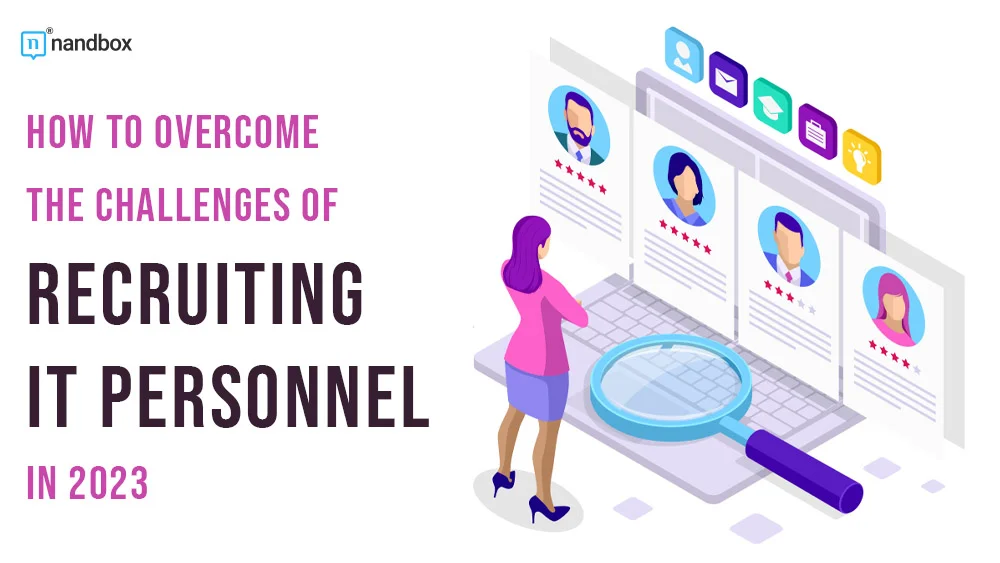Winning The War for Talent: How to Overcome the Challenges of Recruiting IT Personnel in 2023
In the fast-paced world of technology, recruiting top IT talent has never been more challenging. As the digital landscape continues to evolve, so do the challenges recruiters face in attracting, engaging, and retaining skilled IT professionals. In 2023, recruiters are up against unique challenges that require innovative solutions and strategic approaches. Let’s delve into the top 10 recruitment challenges in 2023 and win the war for talent.
1. Talent Shortage
The global talent shortage is expected to continue in 2023, making it difficult for recruiters to find qualified candidates and winning the war for talent. With demand for skilled workers outpacing supply, it is becoming increasingly difficult to find and hire qualified candidates.
A 2023 ManpowerGroup study found that 54% of employers worldwide experience difficulty filling open positions. The talent shortage is particularly acute in the technology industry, where demand for IT professionals grows. However, it also impacts other industries, such as healthcare, manufacturing, and finance.
Best Practices
- Use technology tools to automate tasks and streamline the recruiting process.
- Partner with universities and other educational institutions offering an online degree in computer science and other IT courses to identify and recruit talented students.
- Offer competitive salaries and benefits.
2. Attracting the Right Candidates
In today’s fiercely competitive job market, attracting the best and brightest candidates is essential for businesses of all sizes. To do this, companies must have compelling job descriptions and strategic outreach efforts.
Research shows that candidates are more likely to apply to companies with a strong online presence and positive employer reviews. A 2023 LinkedIn study found that 75% of candidates say that they are more likely to apply to a reputable company.
Best practices
- Write compelling job descriptions that highlight the benefits of working for your company.
- Promote your company’s culture and values on social media and other channels.
- Use social media to reach out to potential candidates and share job openings.
3. Targeting Passive Candidates
Passive candidates are not actively looking for a new job but may be open to new opportunities. A CareerBuilder study found that 70% of employed workers are open to new job opportunities.
Employee referrals are one of the most effective ways to find qualified candidates. Recruiters can reach out to passive candidates through social media, networking, and employee referrals.
Best practices
- Use social media to connect with potential candidates and build relationships.
- Attend industry events and network with potential candidates.
- Encourage your employees to refer their friends and colleagues for open positions.
4. Engaging with Qualified Candidates
A Glassdoor study found that 69% of job seekers say a positive candidate experience is important when deciding whether to accept a job offer. Once recruiters have found qualified candidates, they must keep them engaged throughout the hiring process.
This means responding to inquiries promptly, providing clear and concise information, and moving candidates through the process quickly and efficiently. In the same study, 40% of job seekers said they abandoned a job application because it was too long or complicated.
Best practices
- Respond to inquiries from candidates promptly and professionally.
- Provide clear and concise information about the job and the hiring process.
- Move candidates through the hiring process quickly and efficiently.
5. Reducing Time-to-Hire
An Aberdeen Group research found that companies that hire quickly outperform their competitors regarding revenue growth, profitability, and customer satisfaction. The longer it takes to hire a new employee, the more costly and disruptive it is for the company.
Recruiters can reduce time-to-hire by using technology to automate tasks, streamline the hiring process, and make timely decisions.
Best practices
- Use technology to automate tasks such as screening resumes and scheduling interviews.
- Streamline the hiring process by eliminating unnecessary steps.
- Make timely decisions about candidates so that you keep them from other companies.
6. Building a Strong Employer Brand
A strong employer brand can help recruiters attract and retain top talent. Another LinkedIn study found that 75% of job seekers are more likely to apply for a company with a strong employer brand.
Recruiters can build a strong employer brand by creating a positive employee experience, promoting the company’s culture and values, and being active on social media.
Best practices
- Create a positive employee experience by fostering a culture of respect, collaboration, and innovation.
- Promote your company’s culture and values on social media and other channels.
- Be active on social media and engage with potential candidates.
7. Creating an Efficient Recruiting Process
An optimized recruiting process saves time and resources, ensuring a seamless candidate experience. In the same Aberdeen Group study mentioned above, it was found that companies with a well-defined recruiting process have a 32% faster time-to-hire rate.
Best practices
- Define your hiring process and create a timeline for each step.
- Use technology to automate tasks, such as screening resumes and scheduling interviews.
- Streamline the hiring process by eliminating unnecessary steps.
8. Eliminating Bias in Hiring
Unconscious biases can influence hiring decisions, affecting diversity and inclusion efforts. A recent Harvard Business Review study found that 75% of job seekers have experienced some form of bias during the hiring process.
Recruiters must be aware of their own biases and take steps to eliminate them from the hiring process. Consult with hiring professionals and business psychology degree holders for expert guidance.
Best Practices
- Use objective criteria and structured interviews to assess candidates fairly.
- Provide training to hiring teams to recognize and mitigate biases.
- Audit job descriptions and recruitment materials for unbiased language and imagery.
9. Securing a Positive Candidate Experience
A positive candidate experience is essential for attracting and retaining top talent. In the same Glassdoor study, 56% of job seekers said they would be more likely to accept a job offer from a company that provided them with a positive candidate experience.
Best Practices
- Respond to inquiries promptly and professionally. If you cannot respond immediately, let the candidate know when you can get back to them.
- Provide clear and concise information about the job and the hiring process. Be honest about the challenges and rewards of the role.
- Treat all candidates with respect, regardless of their experience or qualifications.
10. Implementing Data-Driven Recruitment
Data-driven recruitment can help recruiters make better decisions and improve their overall results. Recruiters can use data to track their progress, identify areas for improvement, and make informed decisions about their recruiting strategy.
Best Practices
- Track your progress. Use data to track key metrics such as time-to-hire, source of hire, and candidate quality. This data will help you identify areas where you excel and need to improve.
- Identify areas for improvement. Use data to identify the steps in your recruiting process that are taking the longest or where candidates are dropping off. Once you have identified these areas, you can take steps to improve them.
- Make informed decisions. Use data to make informed decisions about your recruiting strategy. For example, you can use data to determine which job boards are most effective for reaching your target candidates.
Conclusion
The recruitment challenges in 2023 are complex and ever-changing. However, by following the best practices outlined in this article, recruiters can increase their chances of success, winning the war for talent.
By building a strong employer brand, creating an efficient recruiting process, eliminating bias in hiring, securing a positive candidate experience, and implementing data-driven recruitment, recruiters can attract and retain the best IT talent in 2023 and beyond.
As technology continues to shape the future of work, a proactive, adaptable, and data-informed approach to recruitment will be the key to attracting and retaining the best IT talent in 2023 and beyond.





